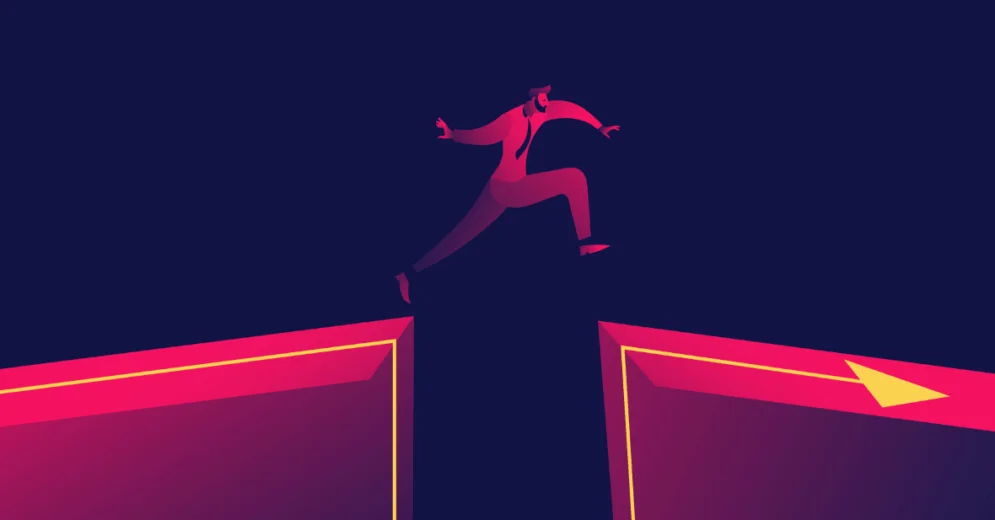Perhaps one of the most common – and normal – situations we can go through in adult life is the feeling that we are in the wrong profession.
This feeling awakens a desire for change, for new horizons and challenges. But along with these motivations comes a feeling of fear and insecurity. After all, change is never easy, especially a big and significant change like a career transition.
To ease this insecurity, it is important to seek more information about the change you want to make.
In this article, we will present to you 5 essential factors that you should take into consideration when you decide to switch to UX Design. Check them out!
Do I need a background in Design to switch to UX Design?
First of all, let's make it clear that you don't need to have a background in Design or technology to switch to UX!
The UX Design area is multidisciplinary and companies value professionals who come from different areas. This is because different perspectives add more value and assertiveness to the development of projects.
In our MID program, we have examples of students who managed to transition to UX Design coming from the following fields:
- Law;
- Business Administration;
- Advertising;
- Customer Service;
- Marketing;
- Psychology;
- And others.
Some fields indeed have more similarities with UX. Graphic Design itself has some concepts and tools that intersect with UX.
However, it doesn't mean that a graphic designer won't have to learn new theories and concepts.
UX Design has several methodologies, theories, and specific tools. Therefore, those who think that just having a background in design is enough to switch to UX are mistaken.
Besides these technical skills, it is important that the UX professional also has some behavioral skills, known as Soft Skills. In other words, it is important to have empathy, communication, and teamwork skills, for example.
Reading Tip: 7 Mistakes to Avoid When Transitioning to UX Design
5 factors you should know before changing to UX Design
Having answered the background question, it is also important to point out some important matters about the process of switching to UX Design.
As we mentioned at the beginning of this article, career changes are not simple decisions to make.
In this sense, it is important that you know some important factors before you decide to switch to UX.
1) Study time

Transitioning to UX design requires gaining new knowledge, and the only way to acquire that knowledge is through dedicated study.
Therefore, it is important to keep in mind that dedication to studying is essential for successfully transitioning to a career in UX Design.
"But how long do I need to study before I get my first opportunity in the field?"
The answer to this question is: it depends.
It depends on your dedication to your studies, planning, and commitment to building a portfolio, networking, and looking for jobs in the market.
However, to give you a brief idea, most of our MID program students land their first job in the field between 6 and 10 months of studies. This time is quite short if you compare it to the time it takes to go to college or to pursue a graduate degree, for example.
But it is important to reiterate that it all depends on the context of each student and the individual commitment to their studies.
To illustrate some transition cases, check out these interviews with our MID students:
- From Art Director to UX Designer – Interview With Joyce Almazan
- 4 Job Offers in Product Design in 9 Months – Interview With Thiago Alvarenga
- 3 International Job Offers in Less than 1 Year – Interview with Louise Santos
- How I Switched from Biology to UX Design – Interview with Lívia Assunção
So before you change to UX, know that there is a time frame for this to happen and you should take that into consideration.
Reading Tip: Student Testimonials: What Do They Say About MID Bootcamp?
2) In UX Design you can't stop learning
Continuing education is a theme that is common in many professions, and UX Design is one of them.
Because it is an area closely linked to technology, it is important that the UX Designer never stop learning and keeps up with market trends.
The evolution of technology is fast and we need to be aware of anything new, including new tools, methodologies, and software that can help us in our day-to-day lives.
Therefore, it is crucial that the UX Designer never stops studying!
And, of course, as a result of these studies, the professional will grow even more, improving and having better opportunities in the market.
Here are three success stories of MID students who never stopped studying and have achieved higher heights in UX Design still in the first years of their careers.
Israel Mesquita
Israel Mesquita, for example, got his first job in UX Design in Lisbon after only six months of studies. And he kept on studying, improving himself to get better positions and after a while, with more experience, he left Portugal to live in Austria, in a new company with more opportunities and better pay.
Ínis Leahy
With Ínis Leahy, it was no different. After taking the MID program, she got a temporary position at Facebook. But she wanted the stability of a permanent position. Committed, she kept going through the mentorships, getting our feedback, and gaining experience, and in a very short time she landed a permanent position at Udemy.
Victor Rosato
Victor Rosato, recently left Itaú Bank to work at Mercado Livre.
These are just a few examples of students who didn't stop studying because they were offered a job, and got new and better opportunities in the UX area.
3) You will need to learn new UX Design tools

Although we have already mentioned the importance of learning, it is essential to emphasize that in order to switch to UX it is crucial to learn tools that are specific to the field.
This does not mean that any prior knowledge is required, but it is important to enjoy and be curious about learning.
UX Design tools may vary according to the specific area you choose to work in. And even then, there are several options of software and programs.
In this sense, the idea is not to know how to work with all these tools, but to know and consider all the possibilities. Over time you will decide which you prefer to work with and expand your knowledge of other tools if necessary.
Some examples of tools that UX Designers use:
- Sketch;
- Adobe XD;
- Photoshop;
- Axure;
- Invision;
- Marvel;
- Principle.
Reading Tip: 27 UX/UI Design Tools For You to Know in 2023
4) Investment
Every change requires some investment, be it time, money, or even both.
In this regard, transitioning to UX is not much different. It is necessary to dedicate time and, in many cases, invest financial resources in courses and other sources of knowledge, such as:
- Books;
- Lectures;
- Events;
- Building a portfolio.
Therefore, it is important to keep in mind that switching to UX requires time and money investments; and you should certainly take that into consideration before deciding to change careers.
5) Develop certain skills

Another important factor that should be taken into consideration when changing to UX is the development of both behavioral and technical skills.
The technical skills (hard skills) are easier to develop because they correspond to learning a tool, software or methodology.
Soft skills, on the other hand, are more complex and generally require more time and experience to develop.
The most common examples of soft skills needed in UX are:
- Communication;
- Teamwork;
- Empathy;
- Emotional intelligence.
While these skills are necessary for many sectors of our lives, a lack of them can make it difficult for you to leverage your career in UX Design. So keep these in mind when you are preparing to make a career move.
What are the benefits of switching to UX Design?
We have already seen that there are some key factors to take into consideration when switching to UX Design. But is all this effort worth it?
Let's talk a bit about the benefits that UX can bring to your life.
Attractive salaries
Certainly, salary is a key issue in deciding to change careers.
In this sense, we can say that salaries for UX Design are very attractive.
This is because the UX market is booming and many companies already understand the importance of this area for their results.
To illustrate, we did a quick search on Glassdoor:

Of course, there are some variables that interfere with this value, such as experience, location, and company. But we can take this information as a reference if we take into account these aspects.
Therefore, the UX Design field can bring good salaries and this is a question to be evaluated when you are making the decision to switch careers or not.
Reading Tip: What’s The Difference Between UX And UI Design? – Understanding Once And For All
Job satisfaction
Job satisfaction is another interesting point of working in UX Design.
Professionals in this area generally feel satisfied for improving people's lives through their solutions and interfaces.
There is even a survey done by NN/g that analyzed the satisfaction level of UX Designers, and the results were very interesting.

The survey showed that the majority, 81%, of professionals are satisfied with their careers. And the reasons are as follows:
- They feel well rewarded and valued;
- They see their work improving people's lives;
- They enjoy being able to use all their skills;
- They feel engaged in solving User-Centered Design problems.
The overall satisfaction average was 5.4 points out of 7. Quite a high value!
Possibility of rapid growth
Rapid growth in the profession is another characteristic of UX Design. Because it is a very high growth segment, even though the professional starts as a junior, they have the possibility to grow quickly in their career.
There are companies that hire the professional even without any experience, only evaluating their soft skills, so that they can mold them and transform them into UX Designers.
In short, it all depends on your dedication and willingness to learn and how much you want to grow in your profession.
International opportunities
Many people dream of living abroad but usually put this goal aside due to the difficulties of emigrating and getting an opportunity in the international market.
However, when it comes to UX Design, everything changes! There are countless job openings outside of Brazil, opening opportunities for professionals to get an international position.
Besides the opportunity to move to another country, it is possible to find remote jobs, where the professional does not need to move.
This category of remote work has become even more common with the 2020 pandemic, in which companies have had to reinvent themselves because of the social distancing.
Reading Tip: Remote Work: What is the Outlook During and After the Pandemic?
Many MID students have already landed international job opportunities:
- Leonardo Spolador: lives in Brazil, but works for an American company, holding the position of UX Designer. In the interview he gave us, Leonardo tells us about the challenge of working remotely;
- Daniel Hildebrant: switched from Graphic Design to Product Design and works in Canada;
- Rodrigo Medeiros: Rodrigo faced the challenge of moving to Portugal without a European passport. He soon got a position as Product Designer in one of Portugal's 3 largest technology companies, OutSystems.
We hope this article has provided valuable insights into the UX design industry and will assist you in making informed decisions about your career path.
We understand that changing careers can be daunting, but anything is possible with careful planning and preparation!








